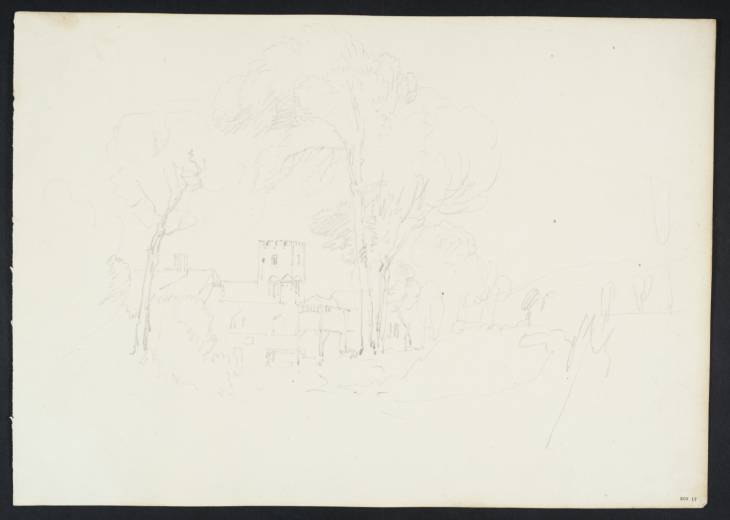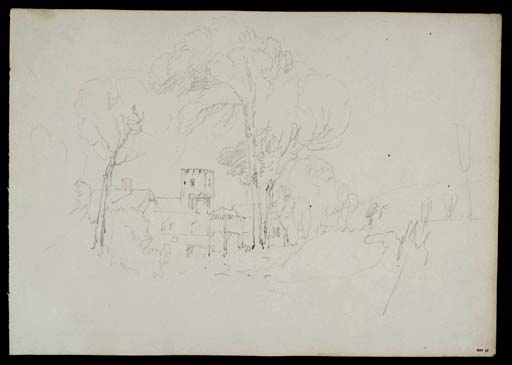Joseph Mallord William Turner Goring Church and Mill, from the River 1805
Image 1 of 2
Joseph Mallord William Turner,
Goring Church and Mill, from the River
1805
Joseph Mallord William Turner 1775–1851
Goring Church and Mill, from the River 1805
D05921
Turner Bequest XCV 17
Turner Bequest XCV 17
Pencil on white wove paper, 259 x 365 mm
Inscribed by John Ruskin in red ink ‘17’ bottom right
Stamped in black ‘XCV 17’ bottom right
Inscribed by John Ruskin in red ink ‘17’ bottom right
Stamped in black ‘XCV 17’ bottom right
Accepted by the nation as part of the Turner Bequest 1856
References
1909
A.J. Finberg, A Complete Inventory of the Drawings of the Turner Bequest, London 1909, vol.I, p.246, XCV 17, as ‘Church seen between trees’.
1993
David Hill, Turner on the Thames: River Journeys in the Year 1805, New Haven and London 1993, pp.106, 107 reproduced pl.155, 171, as ‘Goring Church and Mill...’.
This was a right-hand page from the sketchbook. Turner made two drawings of Goring in this sketchbook (see also the more distant view, Tate D05923; Turner Bequest XCV 19) and an oil sketch of a view similar to the present one but from a little further downstream (Tate N02704),1 suggesting that he paused here for the day. The view is from near the lock, with the mill to the left and, framed by elegantly over-arching trees, the Norman church of St Thomas of Canterbury with its distinctive external stair-turret at its north-west corner. Focused on this motif, the drawing is largely devoid of foreground, but in the oil Turner has begun to fill this in with cattle watering and their reflections in the river. The pencil drawings were doubtless made first, to fix the scenery in his mind and choose a viewpoint, and as Hill observes the lighting in the oil, from behind and to right of the painter, suggests it was the work of an afternoon; it is in his opinion ‘the most unhurried, careful, and complete’ of the oils on canvas of Thames scenery arising from this tour.2 Turner’s friend, the architect John Soane, came from Goring and his company on a fishing expedition this summer (see the view of Pangbourne from this sketchbook, D05920; Turner Bequest XCV 16) perhaps accounted for time spent there.
John Gage’s earlier suggestion that the oil was painted entirely out of doors3 is disputed by Martin Butlin and Evelyn Joll on the grounds that only parts of it are carried nearly to completion while some of the white ground is left bare, but this selective focus is only an extension of that in the drawings certainly made on the spot, and would have allowed Turner to collect what he needed for future work in the studio, had he decided to complete the picture. Butlin and Joll do not mention the related drawing and credit the identification of the oil as of Goring to Mr J.R. Millar, 1976 (‘the church tower and much of the mill are exactly the same today’).
Verso:
Blank. Laid down.
David Blayney Brown
February 2009
How to cite
David Blayney Brown, ‘Goring Church and Mill, from the River 1805 by Joseph Mallord William Turner’, catalogue entry, February 2009, in David Blayney Brown (ed.), J.M.W. Turner: Sketchbooks, Drawings and Watercolours, Tate Research Publication, December 2012, https://www


